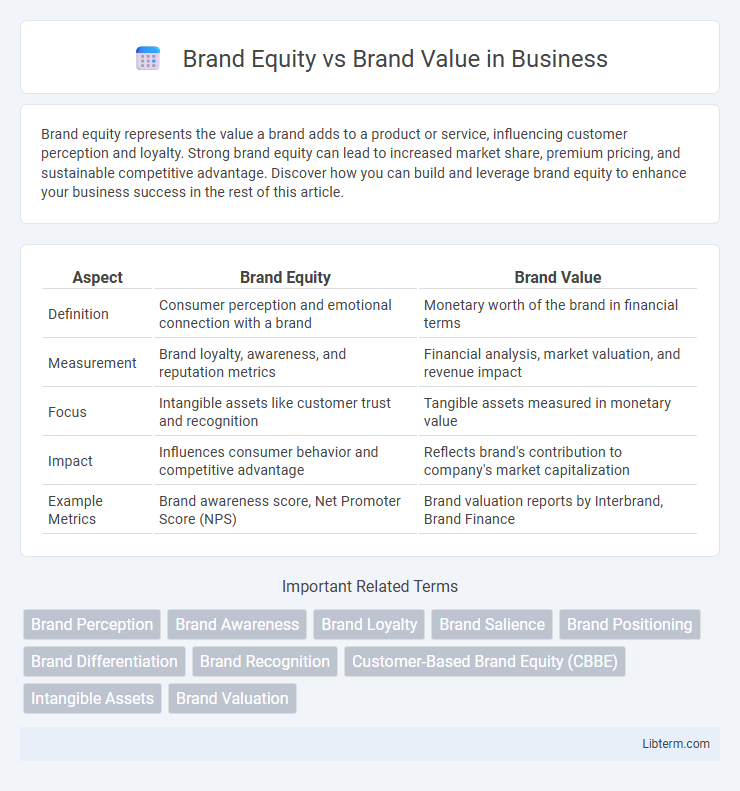Brand equity represents the value a brand adds to a product or service, influencing customer perception and loyalty. Strong brand equity can lead to increased market share, premium pricing, and sustainable competitive advantage. Discover how you can build and leverage brand equity to enhance your business success in the rest of this article.
Table of Comparison
| Aspect | Brand Equity | Brand Value |
|---|---|---|
| Definition | Consumer perception and emotional connection with a brand | Monetary worth of the brand in financial terms |
| Measurement | Brand loyalty, awareness, and reputation metrics | Financial analysis, market valuation, and revenue impact |
| Focus | Intangible assets like customer trust and recognition | Tangible assets measured in monetary value |
| Impact | Influences consumer behavior and competitive advantage | Reflects brand's contribution to company's market capitalization |
| Example Metrics | Brand awareness score, Net Promoter Score (NPS) | Brand valuation reports by Interbrand, Brand Finance |
Understanding Brand Equity: Definition and Importance
Brand equity refers to the intangible asset derived from consumer perception, recognition, and loyalty towards a brand, influencing purchasing decisions and competitive advantage. It encompasses brand awareness, perceived quality, brand associations, and emotional connections, which collectively shape customer preference and drive long-term profitability. Understanding brand equity is crucial for businesses to effectively manage brand positioning, enhance marketing strategies, and build sustainable brand strength in the market.
What is Brand Value? Key Concepts Explained
Brand value refers to the financial worth of a brand, quantifying the monetary benefits it generates for a company through customer loyalty, recognition, and market influence. It encompasses tangible assets like trademarks and intangible factors such as brand reputation, customer perception, and market position. Key concepts include brand valuation methods, which assess future earnings attributable to the brand, and brand strength, which influences competitive advantage and pricing power.
Core Differences Between Brand Equity and Brand Value
Brand equity refers to the intangible perception and emotional connection consumers have with a brand, influencing loyalty and recognition, while brand value quantifies the financial worth or market capitalization attributed to the brand. Brand equity encompasses consumer attitudes, brand awareness, and perceived quality, driving long-term business success through brand loyalty. Brand value is a measurable economic asset derived from brand equity, impacting company valuation and investor confidence.
Components That Build Strong Brand Equity
Brand equity is primarily built on components such as brand awareness, brand associations, perceived quality, and brand loyalty, which collectively influence consumer perception and preference. Unlike brand value, which quantifies the financial worth of a brand, brand equity captures the intangible assets resulting from consumer experiences and emotional connections. Strong brand equity drives market competitiveness by enhancing customer trust, facilitating premium pricing, and fostering long-term consumer commitment.
Factors Influencing Brand Value Assessment
Factors influencing brand value assessment include financial performance, market share, customer loyalty, and brand recognition. Intangible assets such as brand reputation, emotional connection with consumers, and perceived quality significantly impact the overall valuation. Competitive positioning and future earning potential also play crucial roles in accurately measuring brand value.
Measuring Brand Equity: Methods and Metrics
Measuring brand equity involves evaluating consumer perception through metrics such as brand awareness, brand loyalty, and perceived quality. Common methods include brand audits, customer surveys, and financial analysis to assess brand strength against competitors. Key data points like net promoter scores (NPS), brand recall rates, and price premiums help quantify the intangible value consumers associate with a brand.
Evaluating Brand Value: Approaches and Challenges
Evaluating brand value involves quantifying a brand's financial worth through approaches like the cost, market, and income methods, each presenting unique challenges such as data availability and subjective assumptions. The cost approach estimates brand value based on historical investments in brand development, while the market approach compares similar brand transactions to infer value. The income approach calculates the present value of future brand-related cash flows but faces difficulties in isolating brand-specific contributions from overall business performance.
Impact of Brand Equity on Market Performance
Brand equity significantly influences market performance by enhancing customer loyalty, enabling premium pricing, and increasing market share. Strong brand equity leads to higher perceived quality and trust, which drives repeat purchases and attracts new customers, ultimately boosting revenue and profitability. Companies with robust brand equity often experience greater resilience during market fluctuations and enjoy competitive advantages that translate into sustained financial success.
How Brand Value Drives Business Growth
Brand value represents the financial worth of a brand as perceived in the market, directly influencing a company's revenue and market share through customer loyalty and premium pricing. Strong brand value enhances customer acquisition and retention, leading to increased sales and competitive advantage in crowded markets. Businesses leveraging high brand value experience accelerated growth by attracting partnerships, investments, and expanding their market presence effectively.
Choosing the Right Focus: Brand Equity vs Brand Value
Choosing the right focus between brand equity and brand value hinges on strategic business goals, as brand equity reflects consumer perception, trust, and loyalty, while brand value quantifies financial worth. Companies prioritizing long-term customer relationships invest in strengthening brand equity to drive repeat sales and brand advocacy. Conversely, stakeholders emphasizing market valuation and acquisition appeal monitor brand value to assess competitive positioning and investment potential.
Brand Equity Infographic

 libterm.com
libterm.com